
Wine Culture and Information since 2002 - Volume 22
 Wine Culture and Information since 2002 - Volume 22 |
|
Issue 40, April 2006 |
Contents |
|
|
Organic Wine |
|
Once again, this month the subject of this editorial is based on our polls, which - although they started just few months ago - are having a considerable success. Like we said the last month, our reader's opinion gives us the chance to think about tastes and trends of wine lovers. We are pretty surprised on how DiWineTaste's readers are expressing their votes about organic wines and how much it is important in choosing a wine. Most of voters have said to be “indifferent” and “not very interested” in organic wine. However, we ask ourselves whether the role of communication about this kind of product is responsible for this result, both in general terms as well as considering this wine category. Communication about organic wine was not very efficient and clearly explaining what an organic food is, was not efficient as well. This is particularly true for organic wine. Food scandals, such as, “crazy cow”, have turned the attention of consumers towards organic products. If at the top ranking of the most bought organic products there is the category of “fresh” products, such as vegetables, fruit and dairies, wine ranking is in the last positions. First of all, what is an organic product? The organic production method respects environment and excludes the use of chemical substances of synthesis (phytopharmacs and chemical fertilizers). All the production phases are controlled and certified by specific organisms with European accreditation. As of wine, the right way to refer to this product is “wine from organic agriculture”. In Italy, organic viticulture is done in 50,000 hectares (about 124,000 acres) and represents 5% of non-organic products. An organic wine is different from a non-organic one for many reasons: the form of sulphur dioxide permitted (for example gaseous sulphur dioxide in liquid solution or salts of metabisulfite) and the total quantity - between 10 and 25 ppm for free sulphur dioxide - acids permitted (such as citric, tartaric and ascorbic). The level of sulphur dioxide permitted in organic wines can be different according to the organism of certification, chosen by the producer, and which controls all the parameters of the disciplinary are respected. Besides the lack of communication for organic wine, it is necessary to consider idea consumers have about organic wine. Unfortunately, many years ago, the quality of most of organic wines was not so high and our feeling is that, still today, wine produced with organic methods is considered by consumers as a bad quality wine. This is not true anymore most of the cases. We can find good organic wines, both from a qualitative and an organoleptic point of view. Many people believe the producers of this kind of wines do not follow all the principles of organic agriculture. However, many organic wines producers, in commercializing their products, do not stress the concept their wines are from organic agriculture, because this element could discourage buyers of distribution chains, wine shoppers as well as consumers to buy the product. The main distribution channel used by organic wine-companies is mainly export, thanks to which 65% of the production is commercialized, whereas the remaining part is distributed in Italy by restaurants. Export is especially directed to the countries of European Union (in particular Germany, where there are many consumers of organic products), Switzerland and, in recent times, the North-American market. If the problem of a non efficient communication about organic products - wine included - keep consumers away from them, another factor to be considered is price. In general terms, organic products are sold at prices higher than 20-30% of non-organic products. If we consider this according to current economical-financial moment, even the amount of money spent to buy wine has been cut down. However, the higher incidence of production costs are paid by consumers. However, most of times, many organic wines have a lower cost than many non-organic wines. At the present time, organic wine is a product destined to a limited number of people. Consumers of this kind of wines are generally those who go shopping in supermarket chains specialized in the selling of organic or biodynamic products. Biodynamic agriculture is different from organic agriculture and it is inspired to Rudolf Steiner's theories about the rhythm and cycles of the soil. Even in this case there are specific organisms certifying the biodynamic products, different from those certifying organic products. There also are biodynamic wines, that is made with grapes cultivated respecting Steiner's principles. By observing in detail what happened in organic wines marketing, we can say that, in spite of some important examples of specific commercial structures (especially in Germany and Switzerland) and which exclusively promoted and sold organic wines, today quality organic wine is more and more easily found in the traditional markets, being successful as well. The production of grapes with organic agriculture methods is rapidly evolving even in new emerging countries (Eastern Europe, Australia, New Zealand, Chile and Argentina). On the Italian market and in the rest of the world, the wines from these countries have been introduced already, including organic ones, at competitive prices. In the worldwide economical-financial scenery, companies which have chosen organic production are experiencing many difficulties in the selling of their wines. In Europe, Germany - which was the favorite market for the selling of organic wines - thanks to the common culture of organic and biodynamic products, imports now a lesser quantity of organic wines from Italy. Organic wine companies are therefore experiencing a lot of difficulties, because they did not consider the economical crisis which Germany is passing through. We wish these producers, after many efforts, will continue to work on quality, on communication about the product and that they will not convert their vineyards to non-organic production. Whether organic viticulture is still a field in expansion or it is having a hard time, this actually is a frequent and non very useful subject. What we can say is that some companies have now abandoned the control system, as they were mainly interested in the funds provided by the European Union and not to the methods of organic production. In some regions, in particular the ones with a lesser viticulture vocation, many companies which did not own a cellar, which gave grapes to cooperative wineries or sold them on their own, in the last eight years entered the control system because of the contributions of Rule CE 2078 for the development of rural business, without increasing the value of their productions, which were vinified together with non-organic ones. The end of this funds has led these companies change their mind about their commitment, because they had no more benefits. What happened in the marketing of organic wine should be something to be remembered, in the hope this can be be a lesson learnt by anyone, both producers and consumers.
|
||||
MailBox |
|
In this column are published our reader's mail. If you have any comment or any
question or just want to express your opinion about wine, send your letters to
our editorial or fill in
the form available at
our site.
|
| I frequently hear about the negative effects of sulfur dioxide on human body. If this substance is noxious, why is it being used in the production of wine? |
| Giorgio Lanari -- Spilamberto, Modena (Italiy) |
| The use of sulfur dioxide in wine making - a non flammable gas soluble in water - is justified because of its stabilizing and preservative effects. Although the tolerance for sulfur dioxide changes from subject to subject, its use is however regulated by specific laws which set the maximum permitted quantities. The use of sulfur dioxide in wine making and in viticulture is called sulfiting. Sulfur dioxide can be used in many phased of wine production. Before harvesting, sulfiting is useful in preventing the development of moulds and bacteria. Sulfur dioxide is added to must in order to stabilize it and it is added to wine in order to prevent oxidation and other chemical faults. |
| Why does phylloxera destroy European vines whereas the American varieties are immune to this parasite? |
| Jacques Barthel -- Mérignac, Bordeaux (France) |
| Phylloxera is a parasite attacking vine's roots, sucking nutrients and therefore causing a progressive weakening of the plant with the result of a reduction in fruit yields. The effects of phylloxera do not alter the taste of wine, although, as time passes by, it is necessary to replant the vineyard. The origin is the eastern area of United States of America, where vine varieties resistant to this parasite grow. It is believed that, in the course of time, these vines have developed a thicker and stronger rootstock which makes phylloxera attacks useless. The thinner rootstock of Vitis Vinifera - the European species - allows phylloxera to be successful in its attacks therefore sucking precious nutrients. For this reason, young vine plants of Vitis Vinifera are grafted on rootstocks of American varieties resistant to phylloxera, therefore avoiding its devastating effects. |
Napa ValleyNot only the most famous wine area in California, but also in the United States of America, Napa Valley is famous for its wines produced with international grapes and with the local Zinfandel |
|
Napa Valley is the most famous wine area in California and surely of all the United States of America. The fame of this area is such that frequently Napa Valley is considered as synonym of American wine, as to shade other interesting areas, not only those in California. Strongly based on the production of wine with the most famous “international” grapes, Napa Valley is appreciated in the world for the “international” style of its wines, from white ones to red ones, as well as sparkling wines produced with classic method system. Maybe, it is the lack of ancient traditions - just like in other wine areas with recent history - which allows Napa Valley to make use of the most modern technologies and methods of production, also supported in this by the American quality system - AVA (American Viticultural Area) - giving more chances to the enterprise of the wineries without following to traditional principles. Anyway, in this “international” and modern scenery it is possible to find an ancient grape, now considered as an autochthonous grape of the United States of America: Zinfandel. Although it is not so clear how and when Zinfandel arrived in the United States of America, different theories were proposed, and it is believed there is a strong connection with Primitivo - typical in Apulia, Italy - and with Plavac Mali, typical in Dalmatia. Two similar grapes coming from Zagarese, a grape variety from the Balkans. What it is possible to say for sure is that Zinfandel has been introduced from Europe and was known in the United States of America since nineteenth century and the grape was already used for wine production. Whatever the origins and causes which brought this grape to the other part of the Atlantic ocean, today Zinfandel is considered as an autochthonous grape of the United States of America.
History of California - according to a wine production point of view - began earlier than nineteenth century. Some Franciscan monks introduced - after the half of 1700's - vine in the lands of California. In the beginning was introduced mission grape, followed by other European grape varieties with which, while viticulturists of the eastern coast did not know about this and tried hard for the same goal, they succeeded in making wine for the first time in the United States of America by using European varieties. The history of viticulture and of enology in Napa Valley area began later, exactly in 1838, when George C. Yount planted his first vineyard with Mission grape. The first results came in 1840, when the first wines were produced with the grapes from these vineyards. George C. Yount's production was intended for personal use and it will take a little more than twenty years to see the birth of the first commercial winery. In 1861, was established the first winery in Napa Valley thanks to Charles Krug, followed by Schramsberg in 1862, Beringer in 1876, Inglenook in 1879 and Beaulieu Vineyards in 1900. The development of enology in Napa Valley was - at those times - pretty quick and solid: in the course of just twenty years, it was possible to count in this area more than 160 companies focused on viticulture and wine production. The quality of wines at those times was not certainly comparable to those produced in Napa Valley today, although wine production began to play an important role. The strong expansion was stopped in the 1880's - just like in Europe - with the arrive of phylloxera, which devastated Napa Valley vineyards. It was then canceled the patient selection work made by Napa Valley viticulturists on the potentialities of European varieties in different areas. Phylloxera was not the only factor which stopped Napa Valley viticulture and wine production. When the first signs of a reprise were noticed, another determinant event affected the development of enology, not only of Napa Valley, but of all the United States of America. This time the responsibility was not because of natural events, but to the intervention of man and to his laws. From 1920 to 1933, viticulture and wine production, as well as the production of any alcoholic beverage, was severely limited and reduced by the institution of prohibitionism, which forbade the production, transport and sale of any alcoholic beverage. During this period, only the production of sacramental wine was allowed, or anyway wines having therapeutic properties. Prohibitionism, which determined the end of many wineries, did not however determine the decline of consumptions - which in facts increased in that period - while boosting home made and clandestine production. Only few wineries survived the effects of Phylloxera and prohibitionism. The few ones which succeeded were involved in the production of sacramental wines and to the sale of grapes for home wine making. The effects of these two events will be evident until the 1950's, when in Napa Valley existed a little more than a dozen of wineries. Tangible signs of reprise will occur in the 1960's, when Joe Heitz established - in 1961 - “Heitz Wine Cellars”, in 1966 Davies family resumed Schramsberg's activity, and in the same year Robert Mondavi left the family company Charles Krug Winery, establishing his own winery. In the following years, many wineries were established in Napa Valley, and today there are about 200 companies producing wine with grapes coming from the vineyards cultivated on an area of more than 13.700 hectares (about 33,800 acres). Today, Napa Valley is considered one of the most important wine production areas, both for quality and for the enological model strongly based on modern and advanced criteria, in a perfect “international” style.
|
||||||||||||
|
Napa Valley is in California, North-East from San Francisco, and the wine production area is recognized by the American quality system as Napa Valley AVA (American Viticultural Area). AVA quality system was introduced in 1983 with the aim of identifying American wines, by following the models used in Europe, like the French AOC system (Appellation d'Origine Contrôlée, Appellation of Controlled Origin). Contrary to most of the European quality systems, the criteria regulating AVA system are pretty permissive. While in European quality systems, such as the French one, are defined more strict and precise criteria and parameters, such as grape varieties permitted in a specific area, the maximum yield per hectare and the minimum alcohol by volume of wines, AVA system is essentially based on the geographic definition of viticultural areas. According to the American quality system, the only requirement for a wine mentioning in the label a specific AVA, is that at least 85% of the grapes come from that recognized production area. The recognition of a new area is determined by the proposal of viticulturists. The decision is taken according to the existence of specific characteristics of the area, topographic conditions, such as soil and - in certain cases - historical precedents. In many cases inside a specific AVA can also be defined other production areas, and this is the case of Napa Valley. The whole Napa Valley area is recognized as AVA, and inside its territory are also defined the following viticultural areas: Atlas Peak, Oak Knoll District of Napa Valley, Oakville, Rutherford, Chiles Valley, Spring Mountain District, Diamond Mountain District, St. Helena, Howell Mountain, Stag's Leap District, Mount Veeder, Wild Horse Valley and Yountville.
|
|
The viticultural area of Napa Valley covers the territory of Napa County, with the exception of a small part located in the North-East area of Lake Berryessa. Napa Valley is located North-East from San Francisco, beginning from the southern part of San Pablo Bay which borders San Francisco Bay. The southern part of Napa Valley - according to the climatic regions of California - belongs to the cool region I, whereas the northern part belongs to the warmer region III. Moreover, in Napa Valley is defined part of the territory of Carneros AVA - with the remaining part being in Sonoma area - whose wines do not mention Napa Valley AVA in their label, as opposed to the other AVA sub areas defined in the county which must mention it instead. With the exception of Zinfandel, the viticulture of Napa Valley is entirely based on international grape varieties of French origin. Among white grape varieties, 65% of vineyards in the area are cultivated with Chardonnay. Moreover, among white grape varieties, Sauvignon Blanc, Chenin Blanc, Riesling, Sémillon and Gewürztraminer are cultivated as well. Cabernet Sauvignon is the most cultivated red grape variety in Napa Valley, representing more than 50%. The other typical red berried grapes of Napa Valley include Pinot Noir, Merlot, Zinfandel, Cabernet Franc and Petite Sirah, a grape having no connection with the renowned Syrah typical in Rhône Valley, France. It is believed - although there are some doubts about this theory - Petite Sirah is the Durif grape, a crossing between Peloursin and Syrah grapes, invented in France in the 1880's by doctor Durif, now disappeared from French vineyards. Although Napa Valley is the most famous viticultural area in California, here it is produced only the 4% of the total wine produced in the state. In fact, the area is pretty small and covers - from north to south - a distance of 50 kilometers (about 30 miles), and a variable width between 1.5 and 8 kilometers (1 and 4 miles). The volcanic eruptions of ancient times were responsible for the diversity of soils found in Napa Valley, belonging to eight of the twelve known geologic classifications. A geologic diversity like this allows the production of totally different wines even within few kilometers, also because of the different weather conditions of the valley, cooler in the south, near San Pablo Bay, warmer in the north. Although the geologic richness and the climatic diversity can make everyone believe in Napa Valley it is possible to obtain excellent results with any kind of grape, indeed the best wines are undoubtedly those produced with Cabernet Sauvignon, characterized by a full body and complexity, although in many cases, in these wines are added Cabernet Franc, Petit Verdot and Malbec as well. Among the most important AVA sub areas defined in Napa Valley are mentioned Atlas Peak, Stag's Leap District, Spring Mountain District, Mount Veeder, Howell Mountain, Rutherford and Oakville. Stag's Leap District area - located in the southern part of Napa Valley - is characterized by its vineyards at the feet of rocky mountains and with which are produced its famous Cabernet Sauvignon wines. Other famous areas for Cabernet Sauvignon wines are Rutherford and Oakville. Among white wines, Chardonnay is certainly the most common grape variety and the best areas are Mount Veeder, Spring Mountain and St. Helena. Other interesting wines are produced with Pinot Noir grapes - especially in the cooler southern area - and with Zinfandel, especially in the warmer areas of the north. Defining the style of Napa Valley is pretty hard as the geologic diversity of the area and the climatic differences represent pretty variable factors, in which every area is characterized by its own, most of the cases completely different from all the other ones.
|
Comparing Pinot NoirThe magnificent red grape from Burgundy, capable of producing wines of rare elegance and class, is the protagonist of this month's comparative tasting |
|
Ladies and gentlemen, welcome to the world of elegance and of finesse. Although this introduction could not be agreed by many, it is however certain Pinot Noir is a grape capable of producing wines of which there is a lot to say, good things and bad ones. Pinot Noir - the renowned grape from Burgundy, France - has the fault of not being capable of staying “in the middle” of consumers' choices: it is a grape you love, or you can be completely indifferent to it. Nevertheless, this grape, in its best representations, is capable of producing wines of great elegance, class and finesse, maybe like few others in the world. Grape extremely versatile and, above all, hard to cultivate, Pinot Noir allows the creation of interesting white wines - by paying attention of removing skins soon after crushing - and it is present in almost all classic method sparkling wines, including the famous Champagne. The origins of Pinot Noir are very ancient - it is believed it is present in Burgundy for more than 2,000 years - and it is the protagonist of red wines in Côte d'Or, in particular the ones of Côte de Nuits. A grape being difficult to cultivate and to vinify, Pinot Noir - in the best cases - is however capable of making exceptional wines. If it is true young wines produced with this grape have “simple” aromas of red berried fruits - in particular cherry, raspberry, strawberry and plum - with time they get very complex and pleasing organoleptic qualities of chocolate, game, prune, truffle and, sometimes, smoked hints. However Pinot Noir is a grape which does not give that much in case it is being cultivated in areas with a non favorable climate or with deprecable qualitative criteria. This is the main factor which leaves wine lovers perplexed and the ones who do not like this grape. The difference between great Pinot Noirs and mediocre ones is in fact remarkable and tasting a low quality Pinot Noir it is not amazing, even because the typical tricks used in cellar to make a wine better than it really is, do not help that much.
|
|
The goal of our comparative tasting is to understand the main organoleptic qualities of Pinot Noir according to the wine making techniques used for the production of the three wines. Pinot Noir is a grape which likes cool climate areas and does not like the warm ones much. Despite the homeland of Pinot Noir is Burgundy, in particular the Côte d'Or, this grape is also cultivated in other areas of the world and - in favorable climate conditions - can give good examples of wines even outside the borders of France. Because of its particular organoleptic qualities, the vinification of Pinot Noir hardly makes use of an invasive aging in barrique or other wood containers. Despite barrique and cask are frequently used in the vinification of Pinot Noir, the most common choice, as well as more appropriate, is represented by the use of non excessively toasted wood, in order to keep the integrity and identity of its organoleptic qualities.
The wines selected for this month's comparative tasting are from three different areas of Italy, three good representatives of Italian Pinot Noirs. The first wine selected is Produttori Termeno's Alto Adige Pinot Nero Schiesstandhof. This wine is produced with 100% Pinot Noir and aged for 9 months in barrique, followed by a further aging in cask. The second wine is Ca' del Bosco's Pinèro, a famous winery for the production of excellent Franciacorta. Pinèro ages for 13 months in barrique. The third and last wine of our comparative tasting is Ruffino's Nero al Tondo, an excellent wine produced in Tuscany and aged in barrique for 12 months. As the three wines are generally commercialized some years after harvesting, it will be appropriate to use a serving temperature of 18°C (64°F) in all the three cases. Despite Pinot Noir produces wines with an appreciable crispness, aging, in this case, gives a pleasing roundness which will be properly valued by temperature. Our tasting will be done by using three ISO tasting glasses.
|
||||||||
|
Pinot Noir is a grape not very rich in colorant substances, therefore it is pretty unlike to see wines produced with this grape showing intense and deep colors - such as in case of Cabernet Sauvignon - and its appearance always shows a moderate transparency. Because of a deprecable “culture”, in which it is believed a red wine, in order to be good and of quality, must always show intense and deep colors with impenetrable transparencies, Pinot Noir is frequently discriminated because it does not seem to confirm this theory in most of the cases. After all, if wine would just be what we can see, it would really take a little to make a great wine. However, wines produced with Pinot Noir show pretty variable transparencies, sometimes pretty low as well, a condition which is - as always - determined by the quality of grapes, production area and the techniques used in vinification. The first wine we are going to evaluate is Produttori Termeno's Alto Adige Pinot Nero Schiesstandhof. By holding the glass tilted over a white surface, it will be observed the intensity of the color at the base of the glass. It will be noticed a brilliant ruby red color and, near the border of the liquid mass, towards the opening of the glass, it will be observed nuances of garnet red. The second wine of which we will evaluate appearance is Ruffino's Nero al Tondo. The color of this wine is intense ruby red and - just like for the previous wine - with garnet red nuances. We will now evaluate the last wine, Ca' del Bosco's Pinèro. Just like in the previous wines, the color of Pinèro is brilliant ruby red and, as opposed to the other wines, it shows ruby red nuances instead of garnet ones. It will also be noticed how in all the three wines the transparency is pretty moderate, therefore confirming the non high contents in colorant substances in Pinot Noir.
|
|
One of the most fascinating qualities of Pinot Noir is represented by its aromas. Fresh and fruity, as well as rich and complex, wines produced with Pinot Noir express an elegance and finesse of aromas making them unique. Of course these are qualities which is possible to find in all good wines, however in Pinot Noir have a cleaner and very elegant impact. Even the proper use of barrique and cask contribute to the best expression of the aromatic qualities of red wines from Pinot Noir. Despite it is undeniable the use of wood containers for the aging of wines play an important role, a correct and non invasive use represent in Pinot Noir the best choice. A strong use of barrique in wines produced with this grape would exalt strong wood aromas, while completely covering the finesse and freshness of its aromas. Even for this reason, Pinot Noir is sometimes vinified by using inert container, such as stainless steel or cement. The first wine of which we will evaluate aromas is Produttori Termeno's Alto Adige Pinot Nero Schiesstandhof. By keeping the glass still and in vertical position, we will begin by evaluating opening aromas. The first smell will allow the perception of aromas of cherry and raspberry, two aromas typically found in Pinot Noir wines, in particular cherry. After having swirled the glass, in order to favor a proper oxygenation of the wine, a second smell will be done. It will be possible to perceive from the glass aromas of strawberry, plum, dried rose and geranium as well as tertiary aromas developed from the aging in wood, in particular vanilla, licorice and cocoa. It should be noticed how the aroma of vanilla - typical in wines aged in cask - is pretty limited and balanced, while leaving the right opportunity to the fruity nature of wine to develop, very agreeable. The second wine we are going to evaluate is Ruffino's Nero al Tondo. By holding the glass still and in vertical position, we will proceed with the evaluation of opening aromas. Just like for the previous wine, even in Nero al Tondo it will be perceived aromas of cherry and raspberry, followed by aromas of plum. The second smell - done after having swirled the glass - will allow the perception of strawberry, blueberry and rose as well as a tertiary aromatic sequence, more complex than the previous wine, of licorice, vanilla, tobacco, chocolate, leather, pink pepper and mace. We will now examine Ca' del Bosco's Pinèro, in which it will be possible to perceive opening aromas of cherry, raspberry, plum and blueberry. After having swirled the glass, the aromatic sequence will be completed by aromas of rose and hints of black currant, followed by chocolate, coffee, eucalyptus, vanilla, smoked and hints of black pepper.
|
||||
|
The elegance of Pinot Noir continues to be expressed even in taste. Just like for aromas, the taste of Pinot Noir are characterized by elegant and refined qualities, well supported by its typical crispness. One of the main characteristic of Pinot Noir is in fact acidity that - together with its low content in tannins - make the organoleptic profile of these wines pretty special. However this acidity has some drawbacks, because when it is excessively exalted, it makes the wine unbalanced. Even the low content in tannins of Pinot Noir can be properly balanced thanks to an intelligent aging of the wine in cask or in barrique, while paying attention to not exaggerate on this aspect as this would tend to excessively cover the nature of Pinot Noir. Quality Pinot Noir wines require practice and competence in every phase of the production, from the cultivation of grapes to bottling. The fame of being a difficult grape is certainly true, however this “bizarre” red grape is capable of making extraordinary wines even in taste. The first wine we are going to evaluate is Produttori Termeno's Alto Adige Pinot Nero Schiesstandhof. It should be noticed how the crispness in the attack is pretty evident, however well balanced, something which is different from the typical model of red wine, such as the ones produced with Merlot. It should also be noticed the appreciable astringency, a contribution of the aging in cask - certainly not aggressive and strong, such as in case of Cabernet Sauvignon - however in logic balance with all the other organoleptic qualities. Let's now evaluate Ruffino's Nero al Tondo. Even in this case in the attack is perceived a good crispness and, as opposed to the previous wine, a higher astringency, even in this case, accentuated by the aging in barrique. The last wine to be evaluated is Ca' del Bosco's Pinèro. Even in this case crispness is pretty evident, well balanced by alcohol, just like the previous wines, and astringency caused by tannins is well perceptible as well. It should be noticed, in all the three wines, how the use of cask is very balanced as to allow the appreciation of fruity and flowery qualities of Pinot Noir.
|
|
The three Pinot Noirs of our comparative tasting allowed us to well understand the organoleptic qualities of this grape, as well as the influence of cask and its use. The finish of Produttori Termeno's Alto Adige Pinot Nero Schiesstandhof is persistent, leaving in the mouth pleasing flavors of cherry, raspberry and strawberry, three aromatic qualities typical in Pinot Noir. The finish of Ruffino's Nero al Tondo is persistent as well and characterized by flavors of cherry, raspberry and strawberry, just like the previous wine. The finish of the last wine, Ca' del Bosco's Pinèro, will be persistent with flavors of cherry, blueberry and plum. It should be noticed the aromas and flavors of cherry, as well as raspberry and strawberry, are recurrent qualities of Pinot Noir - such as in the case of our three wines - and the floral qualities usually recall rose and cyclamen. The secret for making a good Pinot Noir, just like in the case of our three wines, is the use of quality grapes - a factor which certainly is determinant for every wine - and that in Pinot Noir represents a further difficulty. Finally, it should be noticed that, despite it is important in the balance and structure of wine, in Pinot Noir the use of cask and barrique will never be excessive, in order to allow the grape to express its elegance.
|
Wines of the Month |
|
|
|
Score legend Prices are to be considered as indicative. Prices may vary according to the country or the shop where wines are bought |
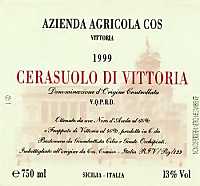
|
|
Cerasuolo di Vittoria 2003 |
|
| COS (Sicily, Italy) | |
| Grapes: Nero d'Avola (60%), Frappato (40%) | |
| Price: € 11.50 | Score: |
| The wine shows a brilliant ruby red color and nuances of ruby red, moderate transparency. The nose denotes intense, clean, pleasing and refined aromas which start with hints of black cherry, blackberry and plum followed by aromas of raspberry, blueberry, carob, violet, tobacco and vanilla. The mouth has good correspondence to the nose, a slightly tannic attack and pleasing crispness, however balanced by alcohol, good body, intense flavors. The finish is persistent with flavors of black cherry, plum and blackberry. The Nero d'Avola grape used for the production of this Cerasuolo di Vittoria ages in cask, whereas Frappato ages in steel tanks. | |
| Food Match: Stewed and braised meat with mushrooms, Roasted meat, Broiled meat and barbecue | |

|
|
Contrada Labirinto 2001 |
|
| COS (Sicily, Italy) | |
| Grapes: Nero d'Avola | |
| Price: € 35.00 | Score: |
| This wine shows a brilliant ruby red color and nuances of garnet red, moderate transparency. The nose reveals intense, clean, pleasing and refined aromas which start with hints of black cherry, plum and blackberry followed by aromas of blueberry, toasted, licorice, tobacco, vanilla, carob and menthol. The mouth has good correspondence to the nose, a tannic attack and however balanced by alcohol, good body, intense flavors. The finish is persistent with flavors of plum, black cherry and blackberry. Contrada Labirinto ages for 24 months in barrique, 6 months in steel tanks followed by 12 months of aging in bottle. | |
| Food Match: Roasted meat, Braised and stewed meat with mushrooms, Hard cheese | |
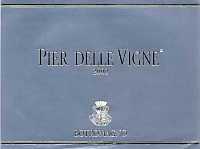
|
|
Pier delle Vigne 2000 |
|
| Botromagno (Apulia, Italy) | |
| Grapes: Aglianico (60%), Montepulciano (40%) | |
| Price: € 10.00 | Score: |
| This wine shows an intense ruby red color and nuances of garnet red, moderate transparency. The nose reveals intense, clean, pleasing and refined aromas which start with hints of plum jam and blackberry jam followed by aromas of raspberry jam, blueberry, carob, tobacco, vanilla, cyclamen, licorice and black pepper. The mouth has good correspondence to the nose, a tannic attack and however balanced by alcohol, good body, intense flavors. The finish is persistent with flavors of plum jam and blackberry jam. Pier delle Vigne ages for at least 18 months in barrique followed by at least 6 months of aging in bottle. | |
| Food Match: Roasted meat, Braised and stewed meat with mushrooms, Hard cheese | |

|
|
Gravisano 2001 |
|
| Botromagno (Apulia, Italy) | |
| Grapes: Malvasia Bianca | |
| Price: € 14.00 - 375ml | Score: |
| This wine shows a brilliant amber yellow color and nuances of amber yellow, transparent. The nose reveals intense, clean, pleasing and refined aromas that start with hints of dried fig, honey and raisin followed by aromas of dried apricot, quince jam, peach jam, date, almond, medlar, honey, vanilla and enamel. The mouth has good correspondence to the nose, a sweet attack and pleasing roundness, however balanced by alcohol, good body, intense flavors, agreeable. The finish is persistent with flavors of dried fig, honey, medlar and raisin. Gravisano ferments in barrique. | |
| Food Match: Hard cheese, Almond and dried fruits tarts, Confectionery | |
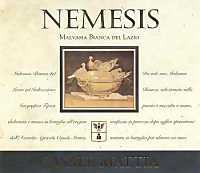
|
|
Nemesis 2004 |
|
| Casale Mattia (Latium, Italy) | |
| Grapes: Malvasia Bianca | |
| Price: € 5.00 | Score: |
| This wine shows a pale straw yellow color and nuances of greenish yellow, very transparent. The nose reveals intense, clean and pleasing aromas that start with hints of hawthorn and apple followed by aromas of broom, almond, pear and plum. The mouth has good correspondence to the nose, a crisp attack and however balanced by alcohol, good body, intense flavors. The finish is persistent with flavors of apple and plum. Nemesis ages in steel tanks. | |
| Food Match: Fish appetizers, Pasta and risotto with fish and vegetables | |

|
|
Frascati Superiore Linea Storica 2004 |
|
| Casale Mattia (Latium, Italy) | |
| Grapes: Malvasia di Candia, Malvasia Bianca, Trebbiano Giallo, Bombino, Bellone | |
| Price: € 10.50 | Score: |
| The wine shows an intense greenish yellow color and nuances of greenish yellow, very transparent. The nose denotes intense, clean, pleasing and refined aromas which start with hints of apple, pear and jasmine followed by aromas of pineapple, hawthorn, broom, almond and plum. The mouth has good correspondence to the nose, a crisp attack and however balanced by alcohol, good body, intense flavors. The finish is persistent with flavors of pear, apple and pineapple. This Frascati ages in steel tanks. | |
| Food Match: Fried fish, Pasta with fish, Roasted fish | |
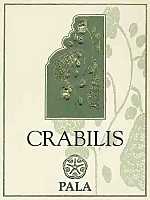
|
|
Vermentino di Sardegna Crabilis 2005 |
|
| Pala (Sardinia, Italy) | |
| Grapes: Vermentino | |
| Price: € 6.00 | Score: |
| The wine shows an intense greenish yellow color and nuances of greenish yellow, very transparent. The nose denotes intense, clean, pleasing and refined aromas which start with hints of peach, pear and pineapple followed by aromas of citrus fruits, litchi, broom, acacia and apple. The mouth has good correspondence to the nose, a crisp attack and however balanced by alcohol, good body, intense flavors, agreeable. The finish is persistent with flavors of peach, pineapple and pear. This Vermentino di Sardegna ages in steel tanks. | |
| Food Match: Fried fish, Risotto with crustaceans and fish, Sauteed fish | |
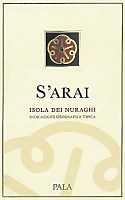
|
|
S'Arai 2002 |
|
| Pala (Sardinia, Italy) | |
| Grapes: Cannonau, Carignano, Barbera, Bovale | |
| Price: € 18.00 | Score: |
| This wine shows a brilliant ruby red color and nuances of garnet red, moderate transparency. The nose reveals intense, clean, pleasing and refined aromas that start with hints of plum and black cherry followed by aromas of blueberry, blackberry, violet, vanilla, tobacco, licorice and carob. The mouth has good correspondence to the nose, a tannic attack and however balanced by alcohol, good body, intense flavors. The finish is persistent with flavors of plum and black cherry. S'Arai ages for 8-10 months in barrique followed by 3-4 months of aging in bottle. | |
| Food Match: Roasted meat, Braised and stewed meat, Hard cheese | |

|
|
Nebbiolo d'Alba Bricco Barone 2003 |
|
| Abbona Marziano (Piedmont, Italy) | |
| Grapes: Nebbiolo | |
| Price: € 9.00 | Score: |
| The wine shows a brilliant ruby red color and nuances of brick red, moderate transparency. The nose reveals intense, clean, pleasing and refined aromas which start with hints of cherry, strawberry and plum followed by aromas of violet, raspberry, rose, vanilla, licorice, cinnamon and rosemary. The mouth has good correspondence to the nose, a tannic attack and pleasing crispness, however balanced by alcohol, full body, intense flavors. The finish is persistent with flavors of cherry, strawberry and plum. This Nebbiolo ages for 12 months in barrique followed by 6 months of aging in bottle. | |
| Food Match: Roasted meat, Braised and stewed meat, Hard cheese | |

|
|
Barolo Pressenda 2001 |
|
| Abbona Marziano (Piedmont, Italy) | |
| Grapes: Nebbiolo | |
| Price: € 26.00 | Score: |
| This Barolo shows a brilliant ruby red color and nuances of brick red, moderate transparency. The nose reveals intense, clean, pleasing, refined and elegant aromas that start with hints of cherry, violet and raspberry followed by aromas of plum, rose, cyclamen, vanilla, tobacco, licorice, strawberry jam, cinnamon, cocoa, cigar box, mace and menthol. The mouth has very good correspondence to the nose, a tannic attack and pleasing crispness, however balanced by alcohol, full body, intense flavors. The finish is persistent with flavors of cherry, raspberry and plum. A well made wine. This Barolo ages for 12 months in barrique followed by 18 months of aging in cask. | |
| Food Match: Game, Roasted meat, Braised and stewed meat, Hard cheese | |
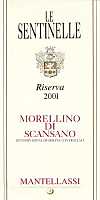
|
|
Morellino di Scansano Riserva Le Sentinelle 2001 |
|
| Fattoria Mantellassi (Tuscany, Italy) | |
| Grapes: Sangiovese (85%), Alicante (15%) | |
| Price: € 14.00 | Score: |
| The wine shows an intense ruby red color and nuances of garnet red, little transparency. The nose denotes intense, clean, pleasing and refined aromas that start with hints of black cherry, blackberry and plum followed by aromas of blueberry, violet, vanilla, tobacco, licorice, chocolate and hints of menthol. The mouth has good correspondence to the nose, a tannic attack and pleasing crispness, however balanced by alcohol, good body, intense flavors. The finish is persistent with flavors of black cherry and plum. This Morellino di Scansano ages for 20 months in barrique. | |
| Food Match: Roasted meat, Braised and stewed meat with mushrooms, Hard cheese | |

|
|
Querciolaia 2002 |
|
| Fattoria Mantellassi (Tuscany, Italy) | |
| Grapes: Alicante | |
| Price: € 16.00 | Score: |
| Querciolaia shows an intense ruby red color and nuances of garnet red, little transparency. The nose reveals intense, clean, pleasing and refined aromas which start with hints of black cherry and plum followed by aromas of blueberry, blackberry, peanut butter, carob, tobacco, vanilla and pink pepper. The mouth has good correspondence to the nose, a tannic attack and however balanced by alcohol, good body, intense flavors. The finish is persistent with flavors of black cherry, plum and blueberry. This wine ages for 13-16 months in barrique. | |
| Food Match: Roasted meat, Braised and stewed meat with mushrooms, Hard cheese | |
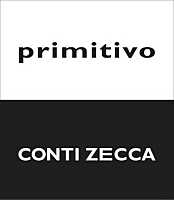
|
|
Primitivo 2003 |
|
| Conti Zecca (Apulia, Italy) | |
| Grapes: Primitivo (85%) | |
| Price: € 9.15 | Score: |
| This wine shows an intense ruby red color and nuances of ruby red, little transparency. The nose reveals intense, clean, pleasing and refined aromas which start with hints of black cherry, plum and blackberry followed by aromas of blueberry, vanilla, tobacco, licorice, coffee, carob and anise. The mouth has good correspondence to the nose, a slightly tannic attack and however balanced by alcohol, good body, intense flavors. The finish is persistent with flavors of black cherry, plum and blackberry. This wine ages for 12 months in barrique. | |
| Food Match: Broiled meat and barbecue, Roasted meat, Stewed and braised meat | |

|
|
Salice Salentino Rosso Riserva Cantalupi 2002 |
|
| Conti Zecca (Apulia, Italy) | |
| Grapes: Negroamaro (80%), Malvasia Nera (20%) | |
| Price: € 8.75 | Score: |
| The wine shows an intense ruby red color and nuances of garnet red, little transparency. The nose denotes intense, clean, pleasing and refined aromas that start with hints of plum and blackberry followed by aromas of black cherry, raspberry, violet, vanilla, tobacco, licorice and carob. The mouth has good correspondence to the nose, a slightly tannic attack and however balanced by alcohol, good body, intense flavors. The finish is persistent with flavors of black cherry and blackberry. Salice Salentino Cantalupi ages for at least 12 months in cask. | |
| Food Match: Broiled meat and barbecue, Roasted meat, Hard cheese | |

|
|
Luenzo 2002 |
|
| Cesani (Tuscany, Italy) | |
| Grapes: Sangiovese (90%), Colorino (10%) | |
| Price: € 20.00 | Score: |
| Luenzo shows an intense ruby red color and nuances of ruby red, little transparency. The nose reveals intense, clean, pleasing and refined aromas that start with hints of black cherry, plum and violet followed by aromas of blueberry, vanilla, raspberry, carob, tobacco and cardamom. The mouth has good correspondence to the nose, a tannic attack and pleasing crispness, however balanced by alcohol, good body, intense flavors. The finish is persistent with flavors of black cherry, plum and raspberry. This wine ages for 16 months in barrique. | |
| Food Match: Roasted meat, Braised and stewed meat with mushrooms, Hard cheese | |
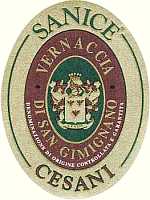
|
|
Vernaccia di San Gimignano Sanice 2003 |
|
| Cesani (Tuscany, Italy) | |
| Grapes: Vernaccia di San Gimignano | |
| Price: € 15.00 | Score: |
| This wine shows an intense golden yellow color and nuances of golden yellow, very transparent. The nose reveals intense, clean, pleasing and refined aromas which start with hints of peach, plum and apple followed by aromas of pineapple, hazelnut, vanilla, praline, peach jam and peanut butter. The mouth has good correspondence to the nose, a crisp attack and however balanced by alcohol, pleasing smoothness, good body, intense flavors. The finish is persistent with flavors of apple, pineapple and plum. Part of this wine ages for 6 months in barrique. | |
| Food Match: Stuffed pasta, Roasted fish, Roasted white meat, Mushrooms soups | |

|
|
Brunello di Montalcino Riserva 1998 |
|
| Mastrojanni (Tuscany, Italy) | |
| Grapes: Sangiovese Grosso | |
| Price: $55.00 | Score: |
| This wine shows a brilliant ruby red color and nuances of brick red, moderate transparency. The nose reveals intense, clean, pleasing, refined and elegant aromas which start with hints of prune, black cherry and blueberry jam followed by aromas of blackberry jam, dried violet, vanilla, dried rose, tobacco, licorice, chocolate, cinnamon, mace and menthol. The mouth has good correspondence to the nose, a tannic attack and pleasing crispness, however balanced by alcohol, full body, intense flavors. The finish is persistent with flavors of prune, black cherry and blueberry jam. A well made wine. This Brunello di Montalcino Riserva ages for 42 months in cask followed by about 12 months of aging in bottle. | |
| Food Match: Game, Roasted meat, Braised and stewed meat, Hard cheese | |

|
|
Brunello di Montalcino Vigna Schiena d'Asino 1999 |
|
| Mastrojanni (Tuscany, Italy) | |
| Grapes: Sangiovese Grosso | |
| Price: $75.00 | Score: |
| This Brunello di Montalcino shows a brilliant ruby red color and nuances of garnet red, little transparency. The nose reveals intense, clean, pleasing, refined and elegant aromas that start with hints of black cherry, plum and blackberry followed by aromas of violet, blueberry, rose, vanilla, tobacco, licorice, cocoa, cinnamon, pink pepper and menthol. The mouth has good correspondence to the nose, a tannic attack and pleasing crispness, however balanced by alcohol, full body, intense flavors, agreeable smoothness. The finish is very persistent with long flavors of plum, black cherry and blackberry. A well made wine. This Brunello di Montalcino ages for about 42 months in cask followed by about 8-9 months of aging in bottle. | |
| Food Match: Game, Roasted meat, Stewed and braised meat, Hard cheese | |
Leone de CastrisAmong the historical wineries of Italy, with more that 80 years of activity, and among the most famous wineries of Apulia, brings the typical wines of Salice Salentino in the world, focusing on autochthonous grapes while experimenting with international ones |
|
The history of the wine from Apulia and of Leone De Castris winery are parallel. The company was established in 1925, from the the marriage between Piero Francesco Leone (1904-1993) and Anna Luisa Filippa de Castris (1901-1950), who joined the two most important families of Salice Salentino. Piero Francesco Leone, second of five sons, when his father passed away, worked to the management of the estates, made of buildings and lands in which he started a transformation process of cultures, planting vineyards on lands which were cultivated with wheat, and managing them “in economy” and part with the help pf many local farmers. Piero, at the age of 20, managed a land patrimony of more than 2,000 hectares (about 50 acres) between Salice, Guagnano, Campi, San Pancrazio and Sandonaci. He was a farmer and became a viticulturist, showing qualities of agronomist, enologist and expert manager. During the 1920's, he further developed wine production in its winery and in 1925 made the first bottling in Apulia, slowly improved in the following years, after having adopted the most modern systems, with the application of new technological processes he learned in his travels and contacts with the most important Italian wineries (from Tuscany and Piedmont) and French ones.
Piero renovated the vineyards, built a modern plant with electrical wine presses, which replaced screw and wood ones; vats and fermentation tanks in cement, adopted modern technologies in the winery and modernized the management of the company, thanks to the collaboration of expert enologists. In 1943 was born Five Roses and then 1954 Salice Salentino, followed a wide range of fine wines. At the end of 1960's, the general management was passed to Salvatore Leone de Castris, son of Piero and Lisetta, who strongly contributed to a new expansion also in the most important international markets. In the 1980's the son Piernicola Leone de Castris joined the company, in charge for commercial aspects and then for general management since the end of 1990's. Piernicola, who manages the company form more than a decade now and with remarkable spirit of management, represents the third generation, after the grandfather Piero and his father Salvatore, of a great winery renowned since the times of World War Two, although the origin of the business dates back to the seventeenth century. Leone de Castris winery's capacity to join management and quality of products, a strong relationship, in the course of the years has been the base for bottling experimentation in rose wines and then for the other wine styles. The winery produces interesting DOC (Denominazione di Origine Controllata) and IGT (Indicazione Geografica Tipica) wines, sparkling wines, a grape distillate and an extra-virgin olive oil. The winery “mission” is: «We want to valorize Salento wines all over the world». Leone de Castris' vineyards are situated in lands of ancient and proven viticulture tradition: Salento. The windy and sunny old vineyards are always fertilized with traditional organic substances and worked by expert hands, with the result of a highly selected production. The transformation of the grapes produced in these lands and vineyards, harvested at the right time of ripeness, into noble wines of superior quality, is a precise commitment, improved by the continuous updating of vinification techniques: always updated to satisfy the more exacting expectations of consumers. Leone de Castris winery, in fact, was the first one in Italy to bottle and sell rose wines. In addition to traditional grape varieties (Negroamaro, Primitivo, Malvasia Nera, Verdeca, Aleatico and Muscat), have been introduced some new varieties (Montepulciano, Merlot, Cabernet Sauvignon, Chardonnay and Sauvignon Blanc), but the main strategic choice is the valorization of autochthonous grape varieties. The winery's cellars cover a wide area. They include a complete bottling line, sterilization and refrigeration equipments; cool and dry cellars for the aging in bottle of some wines, departments for packaging and the automatic storing of empty bottles. The winery also has a large tasting room, a reception and facilities making the winery perfectly efficient and autonomous in every aspect. The efforts for the modernization of the plant, in caring and selecting grapes, in the production of wines reflecting the soul of the territory, have made Leone de Castris winery a highly competitive model and reference point for wine production in Apulia.
The appreciation obtained by Leone de Castris wines from connoisseurs, is the result of different favorable natural circumstances, of the experience and constant commitment. Lands particularly suited to the cultivation of vineyards, perfectly ripe grapes, appropriate vinification and aging: these are the secrets of success making Leone de Castris wines a favorite choice among consumers. There are different product lines: “Great tradition”, “Wines aged in barrique”, “New generation” and “Sparkling wines”. “Great tradition” includes Salice Salentino Riserva DOC, the well known Five Roses produced with Negroamaro and Malvasia Nera grapes, and Negrino Salice Salentino DOC, a sweet wine from Aleatico grapes. “Rare wines” range includes Pierale, a sweet wine produced with muscat grapes and dedicated to the last generation of de Castris family; Villa Santera, a Primitivo di Manduria DOC; La Rena (Salento Primitivo IGT); Vigne Case Alte Sauvignon, white IGT; Messapia (white Salento IGT); Imago, Salento Chardonnay IGT; Negroamaro Elo Veni, red Salento IGT; Truppere, a Salento Primitivo IGT, which label mention Zinfandel grape. “Wines aged in barrique” range includes four products: Illemos, a Salento red IGT, produced since 1997; Donna Lisa, white Salice Salentino DOC; Donna Lisa, red Salice Salentino reserve DOC; Messere Andrea, red Salice Salentino DOC. The products of “The new generation” range are: Maiana, red Salice Salentino DOC; Maiana Rosè DOC; Maiana Bianco DOC; Locorotondo DOC; Ursi, a natural fermentation white sparkling wine produced with Verdeca and Chardonnay grapes; Medaglione red Salento IGT; Medaglione rosato Salento IGT; Medaglione bianco Salento IGT. Moreover, Leone de Castris produces two brut sparkling wines: Donna Lisetta, from Pinot Nero grapes vinified in white and Don Piero, from Chardonnay, Pinot Bianco and Pinot Nero grapes, both dedicated to the ancestors. Finally, the Apulian winery produces a “Nouveau” wine, Salentinello, obtained with carbonic maceration of Negroamaro, Malvasia Nera and Montepulciano grapes.
|
||||||||||||||||||||
|
Score legend Prices are to be considered as indicative. Prices may vary according to the country or the shop where wines are bought |
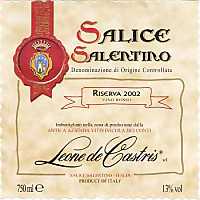
|
|
Salento Salentino Rosso Riserva 2002 |
|
| Leone de Castris (Apulia, Italy) | |
| Grapes: Negroamaro (90%), Malvasia Nera (10%) | |
| Price: € 8.20 | Score: |
| The wine shows an intense ruby red color and nuances of ruby red, little transparency. The nose reveals intense, clean, pleasing and refined aromas which start with hints of black cherry and blackberry followed by aromas of blueberry, plum, violet, vanilla and hints of rubber. The mouth has good correspondence to the nose, a slightly tannic attack and however balanced by alcohol, good body, intense flavors. The finish is persistent with flavors of black cherry and blackberry. This Salice Salentino Reserve ages for 12 months in cask. | |
| Food Match: Roasted meat, Stewed and braised meat with mushrooms, Hard cheese | |
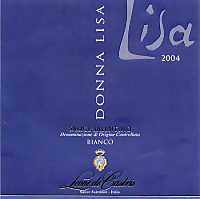
|
|
Salento Salentino Bianco Donna Lisa 2004 |
|
| Leone de Castris (Apulia, Italy) | |
| Grapes: Chardonnay | |
| Price: € 14.00 | Score: |
| Donna Lisa Bianco shows an intense golden yellow color and nuances of golden yellow, very transparent. The nose reveals intense, clean, pleasing and refined aromas which start with hints of apple, plum and pear followed by aromas of citrus fruits, hawthorn, broom, pineapple, peach, vanilla and grapefruit. The mouth has good correspondence to the nose, a crisp attack and pleasing roundness, however balanced by alcohol, good body, intense flavors. The finish is persistent with flavors of apple, plum and pear. This wine ages for about 9 months in barrique. | |
| Food Match: Stuffed pasta, Mushrooms soups, Broiled fish, Roasted white meat | |
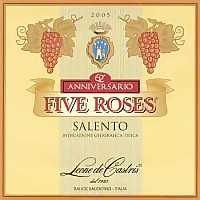
|
|
Salento Five Roses Anniversario 2005 |
|
| Leone de Castris (Apulia, Italy) | |
| Grapes: Negroamaro (80%), Malvasia Nera (20%) | |
| Price: € 8.40 | Score: |
| This wine shows a brilliant salmon pink color and nuances of pale pink, transparent. The nose denotes intense, clean, pleasing and refined aromas which start with hints of cherry, raspberry and peach followed by aromas of strawberry, blueberry, pomegranate, plum, cyclamen and hawthorn. The mouth has good correspondence to the nose, a crisp attack and pleasing roundness, however balanced by alcohol, good body, intense flavors. The finish is persistent with flavors of raspberry, cherry and plum. Five Rose Anniversario ages in steel tanks. | |
| Food Match: Pasta with meat and fish, Roasted fish, Roasted white meat, Mushrooms soups | |
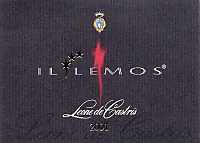
|
|
Salento Il Lemos 2001 |
|
| Leone de Castris (Apulia, Italy) | |
| Grapes: Primitivo (50%), Neogroamaro (10%), Montepulciano (20%), Merlot (20%) | |
| Price: € 19.00 | Score: |
| This wine shows an intense ruby red color and nuances of garnet red, little transparency. The nose reveals intense, clean, pleasing and refined aromas that start with hints of black cherry, plum and blackberry followed by aromas of raspberry, blueberry, violet, vanilla, pink pepper and carob. The mouth has good correspondence to the nose, a tannic attack and however balanced by alcohol, good body, intense flavors. The finish is persistent with flavors of black cherry, plum and blueberry. Il Lemos ages for about 14 months in barrique. | |
| Food Match: Roasted meat, Braised meat, Hard cheese | |

|
|
Salento Messere Andrea 2002 |
|
| Leone de Castris (Apulia, Italy) | |
| Grapes: Negroamaro (85%), Cabernet Sauvignon (15%) | |
| Price: € 15.00 | Score: |
| The wine shows an intense ruby red color and nuances of ruby red, little transparency. The nose reveals intense, clean, pleasing and refined aromas which start with hints of plum, blackberry and black cherry followed by aromas of blueberry, violet, vanilla, cyclamen, licorice and carob. The mouth has good correspondence to the nose, a tannic attack and however balanced by alcohol, good body, intense flavors. The finish is persistent with flavors of plum and black cherry. Messere Andrea ages for about 12 months in barrique. | |
| Food Match: Broiled meat and barbecue, Roasted meat, Stewed meat, Hard cheese | |
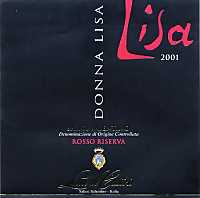
|
|
Salento Salentino Rosso Riserva Donna Lisa 2001 |
|
| Leone de Castris (Apulia, Italy) | |
| Grapes: Negroamaro (90%), Malvasia Nera (10%) | |
| Price: € 24.00 | Score: |
| This wine shows an intense ruby red color and nuances of garnet red, little transparency. The nose reveals intense, clean, pleasing and refined aromas which start with hints of black cherry, plum and blackberry followed by aromas of blueberry, violet, raspberry, vanilla, licorice, cocoa and mace. The mouth has good correspondence to the nose, a tannic attack and however balanced by alcohol, good body, intense flavors. The finish is persistent with flavors of plum and black cherry. Donna Lisa Rosso Riserva ages for about 18 months in barrique. | |
| Food Match: Roasted meat, Braised and stewed meat with mushrooms, Hard cheese | |
| Leone De Castris - Via Senatore de Castris, 26 - 73015, Salice Salentino, Lecce (Italy) - Tel. +39 832 731112 Fax. +39 832 731114 - Winemaker: Giovanni Dimastrogiovanni - Established: 1925 - Production: 2.500.000 bottles - E-Mail: info@leonedecastris.com - WEB: www.leonedecastris.com |
Cellar Journal |
|
This section is reserved to wine producers who want to publish news and information about their business, to announce new products or just for communicating to customers information and promotions about their products and activity. Send news to be published to our e-mail address.
|
News |
|
In this section are published news and information about events concerning the world of wine and food. Whoever is interested in publishing this kind of information can send us a mail to our address.
|
Indian Cooking and WineThe cooking of a country rich in charm and delicious dishes, not only made of rice and curry, in which every region has its gastronomy and its typical bread. A cooking which can be matched to wine |
|
India is considered by many the country of one hundred nations, one hundred dialects, one thousand religions and two thousands gods. It is also a country with a rich gastronomy, different from region to region and from family to family, considered an art rich of social and religious rites. It is the country of spices and curry. Whoever believes Indian cooking is made of rice, curry and chutney only, can certainly be surprised. There is not a specific culinary style, neither a national dish, but an incredible variety of ingredients and preparations. Indian cooking is simple, balanced, made of millenary recipes and principles. Ayurvedics, for example, transcends every composition. A pretty robust and heavy dish will always be attenuated by an acid and digestive base, such as tomatoes, vinegar or lemon. Mixtures of spices play a fundamental role.
|
By comparing the cooking of north to the one of south, it will be noticed a higher presence of bread, grilled meat, a lesser presence of sauces, a higher consumption of yogurt, as well as the characteristic of cooking with ghee, a sort of butter. In the cooking of the north are also found influences from other eastern gastronomies, such as in biryani (dishes made of rice and stuffed with spices, meat, vegetables and sometimes fish) as well as kebabs. In Rajasthan - near the border with Pakistan - it is typical the breeding of sheep. The famous tandoori - also very popular in western countries - is typical in Punjab, and in particular in Delhi, where it was originated from. The cooking of meat in the north provides for marinading, then it is grilled in the tandoor - a sort of oven - usually accompanied by yogurt sauces. Kashmir, in the upper north of India, is famous for the recipes made of meat, chickpeas and its pretty spiced dishes. Here it is found the highest chili pepper production of the country, which use - according to Indian tradition - allows the heating from “inside”, and to diminish this effect it can be used some yogurt. The culinary culture of south India is mainly oriented to the product of the earth, therefore vegetarian, with a considerable consumption of legumes and cereals. In this area the cooking of ingredients is mainly made with oil, dishes are usually accompanied by rice in which are being added different sauces. The preference for the consumption of foods of vegetal origin is also favored by the abundance of fruit trees, in particular cashews, bananas - the red variety, in big and small sizes, very sweet, called butter bananas - lemons, guavas, bred plants, mangoes, papayas and tamarinds. In the southern part, in the tropical coast beginning from Goa, it is common the consumption of fish, crustaceans and seafruits, usually cooked in oil and spiced with curry. The western part of southern India - in the state of Kerala - is famous for coconuts, pineapple and red bananas, as well as for the production of cardamom seeds, one of the most used spice in India. Tamil Nadu, in the eastern part, is famous for its dal - name with which in India are identified about 60 different varieties of legumes, such as lentils, chickpeas, soybeans, peas and beans - prepared with tamarind. The most complex cooking in India is probably the one in the state of Maharashtra, which capital city is Bombay, which makes use of countless ingredients. Famous are achar or pickles (hot pickles) and chutneys, the famous sauces used in every type of food, from rice to bread and to meat, in order to create a very particular contrast of flavors. There are different types of chutney: some are fresh, acid and aromatized with mint or coriander, other are similar to hot and sweet sour jams. Fruit and vegetables are usually spiced, cooked with vinegar and sugar, allowed to rest for some days in order to accentuate aromas. Famous are also kachumbars, salads made with not more than two or three vegetables, in which it is usually found raw onion, seasoned in a pretty simple way, aromatized with mint or coriander. The cooking of western India is sweet, with a moderate use of spices and turmeric. In the eastern part - where are located the states of Bihar, Western Bengal and Orissa - the cooking is characterized by fish and sweets. Typical is the use of the pith of banana tree served as a vegetable.
|
||||||||||||
|
The tandoor is the typical oven of Indian cooking, made of earthenware, whose origin is probably from Central Asia. Tandoor looks like a large jar, with a narrow neck buried in the ground. Before using it, wood pieces are placed on the bottom and then they are ignited. When the sides become incandescent and there are no more flames, the foods to be cooked can be finally inserted. The borders of breads and buns are stuck to the hot side, under the neck, in order to suspend them over the heat. In this way, bread increase its volume, in particular in the borders, while becoming light and the borders get a golden color. The cooking of meat and of fish is usually made by using long skewers in which the meat to be cooked is being spiked, by leaving it in the upper part, and then are propped against the neck of tandoor while making sure the meat is about 30 centimeters away above from embers. During the cooking - which usually requires short times - the meat is sprinkled with melted ghee and its marinade. The typical coppery color of tandoori dishes is caused by spices. This cooking technique - typical in the northern parts - is usually defined dietetic as it makes no use of fats. However, the secret consists in the long times of marinading in yogurt, lemon and spices.
|
|
Lassi is one of the typical beverages of India consumed during meals. It is prepared with boiled pasteurized milk, to which it is added lemon and it is allowed to rest until the day after. The whey is then mixed to dahi - salted yogurt - mint leaves or coriander and rose water. Tea and coffee are always consumed off meals, in the morning or in the afternoon, preferable with milk. Tea, served without milk, is generally consumed hot in the evening, in order to favor digestion, the way it is suggested by sacred books. Indians consumes lots of fruit juices, coconut water, that is the liquid inside the coconut and not to be confused with coconut milk, diluted flower syrups, and refreshing beverages - sometimes salted and sweetened at the same time - aromatized with lemon or rosewater.
|
|
In India bread is a food impossible to replace with anything else and it is always present in the table. In ancient times, Indian bread was flat, with no yeast, known as roti. The subsequent influence of Muslims has introduced a variety of leavened breads, including the famous naan. There are also leavened roti, such as the ones from Kashmir and Bombay. Among the most common types of breads are mentioned:
|
|
Despite Indians are used to match their foods with fruit juices or water, it can be however used a good wine as well. As always, it is necessary to understand how a dish was made in order to choose the right enogastronomical matching. Indian cooking is rich in spices - ingredients that will increase the aroma of the dish as well as a basically bitter taste - therefore it will be appropriate to choose an aromatic and dry wine produced with aromatic grapes, such as Gewürztraminer and Muscat Blanc, and characterized by a good roundness. Other wines which can be generally matched with Indian cooking are rose wines, crisp and aromatic. Rose wines also have the advantage of a higher structure than white wines, which will be useful in the matching with more robust dishes and with all the preparations made of legumes, cereals and flours. As for the cooking of meat in tandoori, it can be matched red wines, even with a good structure and good roundness - and according to the type of meat - however are also pretty interesting the matching with Sangiovese and Pinot Noir wines.
|
BasilHerbaceous plant, coming from India and Indonesia, with its characteristic aromas, it is used as a condiment for foods, in ayurvedic medicine, herbal medicine and cosmetics |
|
Basil (Ocimum Basilicum), belongs to the family of Lamiaceae (Lamiales), its leaves show an intense green color on the upper side and a green-gray color in the bottom side. The term “basil” derives from the greek word Basilikos meaning “herb worth of kings”. Cultivated in all the countries of the world, rich in volatile oils which vary according to the composition even in the same variety and according to growing factors. The most aromatic leaves, sweet and fragrant, are the ones picked soon before blossoming, as they contain a higher quantity of oily substances determining the aroma, whereas the elder leaves tends to have a more piquant taste.
|
|
Basil was known since the times of Egyptians, who used it, together with other essences, during religious ceremonies. It seems it was also used as an ingredient for the preparation of the balms used for mummification. In the Middle Age, it was believed to have magic properties, it was used as a defense against “basilisk”, a monster which looked like a poisonous serpent. The origins of Basil are from India and Indonesia. It was probably introduced in Europe by Greeks and Romans, coming from the commercial routes which crossed the Middle East. Ancient Romans considered it the symbol of lovers, and it was also used as an aromatic herb in cooking. Apicius mentioned basil in a recipe with peas. In England was introduced around the sixteenth century, whereas in America will be introduced in the seventeenth century.
In its homeland - India - the use of basil in cooking is pretty limited. A type of basil - Ocimum Sanctum - the famous “Tulsi” - is considered a sacred plant dedicated to Vishnu and Krishna, its seeds are used for the making of mala, and are being consumed by the ones who practice a vegetarian diet or want a more sound lifestyle. In ayurvedics, the traditional Indian medicine, basil is used as a remedy for many diseases. In India is pretty common to plant basil in order to check the salubrity of a soil: the good growing of the plant makes a place or soil good. Moreover, it is believed the presence of basil, or better to say, Tulsi, can keep evil spirits away while attracting divine blessings. The leaves are used during religious ceremonies dedicated to Vishnu, in particular the ones in favor of family wellness. In India a plant of basil cultivated in front of the house, keeps unwanted insects away, although anyone knowing the Indian traditions, will say it is a sign of the culture and the religious beliefs of the family. The soil surrounding the plant, is manured with cow's manure, an animal considered sacred in India. In the most rich houses are being cultivated many plants of tulsi, in order to make a small sacred garden called tulsi-van or vrindavan. Sacred Hindu writings suggested to consider tulsi not as a simple plant, but as a natural representation of the gods Vishnu or Krishna. Whoever had the chance to travel to India will certainly have noticed many people use a series of small balls tied with a string (Mala), resembling the chain used by catholics: the small balls are made from a sacred plant, Indian basil, tulsi's mala. In order to understand the respect Hindus have for this plant, it is worth remembering that Englishmen, when they wanted an Indian to swear about something - and while not having an equivalent to the Bible - they forced Indians to swear on tulsi. In the western world basil is the sign of fertility. Boccaccio told the story of Lisabetta who, after having hidden the head of her lover in the soil of a basil vase, she watered him with her tears. A different opinion had Van Helmont (1577-1644), a Flemish doctor, who believed basil left between two bricks made the plant to get transformed into a scorpion. Use of Basil Basil is an annual plant which likes tempered climates and does not stand to frosts. It can reach a height of 30-40 centimeters (11-15 inches). An interesting and curious characteristic is that basil, when cultivated in an adverse environment, tends to lose its main characteristics, it gets oily and thick, lose its characteristic sweet and delicate aroma while getting harsh and strong smells. In Genoa, Italy - where Basil is extensively cultivated, in greenhouses at tropical temperatures and humidity - the harvesting is done when the plant reaches the height of twelve centimeters (5 inches), in order to get the best out from the organoleptic characteristics. People from Genoa are very exacting about basil. In Liguria there is the tradition of cultivating basil in earthenware vases left in house's balconies. To summarize things up: the best basil is the one cultivated in a proper environment and consumed young. The aroma of fresh basil and dried basil cannot be compared. Fresh basil can be kept for a short time in the refrigerator, however the best way to keep it is undoubtedly keep the leaves in oil. According to Italian tradition, small leaves of basil are washed and dried, then are put in a jar and sprinkled with some salt, then the process is repeated, likewise, with other basil leaves, some salt, more basil leaves and so on, until the jar is full. When the jar is full, it is filled with olive oil in order to completely cover the leaves, it is sealed and kept in a fresh place or in the refrigerator, away from light sources. By using this method, basil can be kept for a pretty long time without losing its organoleptic qualities, even though as time passes by, leaves with tend to get a black color. Moreover, basil kept according this method is ideal for the preparation of “pesto alla genovese”. Basil certainly is not a characteristic ingredient of northern European cooking. It is found in southern countries of Europe, in Italy, in Greece and in the countries of the Mediterranean. The most fascinating use of basil in cooking can be probably found in “pesto alla genovese”, which, in different expressions, is common in every part of the coast from Genoa to beyond the borders of Italy, in Provence, where it is called pistou. The ingredients of “pesto” are basil, garlic, salt, olive oil, pecorino cheese and/or Parmesan cheese, pine kernels or walnuts, finely crushed in a mortar until getting a thick sauce. It should be noticed some versions of “pesto” do not make use of garlic. In Italy - where it is now common in every region - it is used as a condiment for pasta, in particular “trenette”, as well as rice and canapes. The spreading of basil has led industry to offer consumers jars of ready to use “pesto”, of course not comparable to fresh pesto, however it is maybe better to use this kind of pesto instead of not enjoying it at all. A typical product of Apulia is basil oil. Oil is being naturally aromatized: during crushing, strictly made with mechanical tools, are also crushed some basil leaves, which give oil a fresh and intense aroma. Basil oil is used to season pasta dishes, fish and salads. In southern France pistou is used for soups. In the Italian riviera, it was common to have a snack with a sort of bun stuffed with tomato, salt, olive oil and some basil leaves: a tasty snack, now replaced by other sandwiches. A bun with tomato, oil and basil, is enriched with the flavors and aromas of the ingredients, always different, essence of the earth, different in every season and in every region. The aroma of basil is well matched to tomatoes, and to every dish made with tomatoes, with eggs dishes, such as omelettes or scrambled eggs, with eggplant, fish - in particular mullet and lobster - as well as other recipes. Fantasy and taste, as always, are the limit. In shops can also be found dried basil leaves used for the preparation of sauces, stews and soups. It is better to add basil during the last phases of cooking as it tends to easily lose its characteristic aroma. Some cooks avoid cutting basil leaves with a knife, while preferring to tear it with hands in order to allow essential oils to give all their best aromas. Beyond European countries, basil is used in Malaysia (selaseh) and in India (babuitulsi). There is also basil vinegar, which is prepared by infusing basil leaves in vinegar. The use of basil is not limited in cooking or in religious ceremonies only, but also in cosmetics, herbal medicine and aromatherapy. In herbal medicine is used as a remedy for bad smelling breath, digestion problems, cough, meteorism, nervous headache and headache caused by bad digestion. An infusion of dried leaves is used as a remedy for fever, nausea and abdominal cramps. Basil oil is not recommended in case of pregnancy, kids younger than six, on pretty delicate skin. When consumed in high quantities, the essence of basil can have narcotic effects, when used on the skin it can have an irritating effect. The plant contains an essential oil rich in estragol and eugenol, as well as linalool and terpenes. In cosmetics it is used as a tonic and deodorant: it is enough to put 15 leaves of basil in a cotton bag and to add it to the bath. As a tonic for the skin, can be useful some leaves of basil and sage macerated in alcohol, subsequently diluted with water. For hair, an infusion of basil used as a lotion after shampooing. In aromatherapy it is used as a stimulant.
|
||||||||||||
AquavitaeReview of Grappa, Distillates and Brandy |
|
|
| Distillates are rated according to DiWineTaste's evaluation method. Please see score legend in the "Wines of the Month" section. |
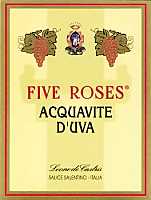
|
|
Acquavite d'Uva Five Roses |
|
| Leone de Castris (Apulia, Italy) | |
| (Distiller: Bonollo) | |
| Raw matter: Negroamaro and Malvasia Nera | |
| Price: € 24.00 - 50cl | Score: |
| This distillate is colorless, limpid and crystalline. The node reveals intense, clean and pleasing aromas of raspberry, cyclamen, cherry and strawberry with almost imperceptible alcohol pungency. In the mouth has intense flavors and a perceptible alcohol pungency which tends ti dissolve rapidly, pleasing smoothness, balanced sweet hint. The finish is persistent with flavors of raspberry, strawberry and cherry. Produced with steam operated alembic stills. Alcohol 40%. | |
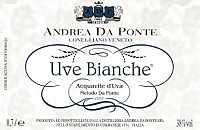
|
|
Uve Bianche |
|
| Andrea Da Ponte (Veneto, Italy) | |
| Raw matter: Malvasia Bianca and Chardonnay | |
| Price: € 18.50 - 70cl | Score: |
| This distillate is colorless, limpid and crystalline. The nose denotes intense, clean, pleasing and refined aromas of grape, pear, apple, banana, broom and hazelnut with almost imperceptible alcohol pungency. In the mouth has intense flavors with perceptible alcohol pungency which tends to dissolve rapidly, pleasing smoothness, sweet balanced hint. The finish is persistent with flavors of grape and pear. Distilled with a bainmarie alembic still. Alcohol 38%. | |

|
|
Grappa di Nebbiolo di Carema |
|
| Revel Chion (Piedmont, Italy) | |
| Raw matter: Pomace of Nebbiolo | |
| Price: € 13.40 - 50cl | Score: |
| This grappa is colorless, limpid and crystalline. The nose reveals intense, clean, pleasing and refined aromas of cherry, plum, violet, rose, licorice, raspberry and hazelnut with almost imperceptible alcohol pungency. In the mouth has intense flavors with perceptible alcohol pungency which tends to dissolve rapidly, pleasing roundness, balanced sweet hint, agreeable. The finish is persistent with flavors of cherry, raspberry and plum. This grappa is distilled with a steam operated alembic still. Alcohol 45%. | |
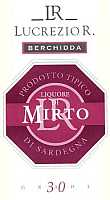
|
|
Liquore di Mirto |
|
| Lucrezio R (Sardinia, Italy) | |
| Raw matter: Mirtle berries | |
| Price: € 10.00 - 70cl | Score: |
| This liquor shows an intense orange red color, limpid and crystalline. The nose denotes intense, clean and pleasing aromas of myrtle and imperceptible alcohol pungency. In the mouth has intense flavors with moderate alcohol perception which tends to dissolve rapidly, sweet, pleasing roundness with intense flavors of myrtle. The finish is persistent with flavors of myrtle and hints of sweetness. Alcohol 30%. | |
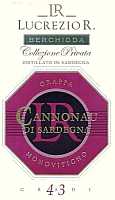
|
|
Grappa Cannonau di Sardegna Collezione Privata |
|
| Lucrezio R (Sardinia, Italy) | |
| Raw matter: Pomace of Cannonau | |
| Price: € 20.00 - 50cl | Score: |
| This grappa is colorless, limpid and crystalline. The nose reveals intense, clean, pleasing and refined aromas of plum, black cherry, violet, hazelnut, licorice and raspberry with almost imperceptible alcohol pungency. In the mouth as intense flavors with perceptible alcohol pungency which tends to dissolve rapidly, pleasing roundness, balanced sweet hint. The finish is persistent with flavors of plum, black cherry and licorice. This grappa is distilled with a bainmarie alembic still. Alcohol 43%. | |
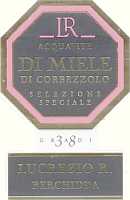
|
|
Acquavite di Miele di Corbezzolo Selezione Speciale |
|
| Lucrezio R (Sardinia, Italy) | |
| Raw matter: Straberry tree honey | |
| Price: € 35.00 - 50cl | Score: |
| This distillate is colorless, limpid and crystalline. The nose reveals intense, clean, pleasing, refined and elegant aromas of strawberry tree honey and beeswax with almost imperceptible alcohol pungency. In the mouth has intense flavors with balanced alcohol pungency which tends to dissolve rapidly, pleasing smoothness, balanced sweet hint, very agreeable. The finish is very persistent with long flavors of strawberry tree honey. Produced with distilled fermented strawberry tree honey. Alcohol 30%. | |
Wine Parade |
|
|
| The best 15 wines according to DiWineTaste's readers. To express your best three wines send us an E-mail or fill in the form available at our WEB site. |
| Rank | Wine, Producer | |
|---|---|---|
| 1 |
| Trento Talento Brut Riserva Methius 1998, Dorigati (Italy) |
| 2 |
| Colli Orientali del Friuli Rosazzo Bianco Terre Alte 2002, Livio Felluga (Italy) |
| 3 |
| Amarone della Valpolicella Classico 1998, Santa Sofia (Italy) |
| 4 |
| Riesling Central Otago 2004, Felton Road (New Zealand) |
| 5 |
| Aglianico del Vulture La Firma 2002, Cantine del Notaio (Italy) |
| 6 |
| Brunello di Montalcino 1999, Castello Banfi (Italy) |
| 7 |
| Palazzo della Torre 2000, Allegrini (Italy) |
| 8 |
| Amarone della Valpolicella Classico 2000, Zenato (Italy) |
| 9 |
| Wine Obsession 2001, Vignamaggio (Italy) |
| 10 |
| Montepulciano d'Abruzzo Riparosso 2001, Illuminati (Italy) |
| 11 |
| Notarpanaro 1999, Taurino (Italy) |
| 12 |
| Chianti Classico Riserva Novecento 2000, Dievole (Italy) |
| 13 |
| Chablis Grand Cru Les Clos 2002, Domaine Billaud-Simon (France) |
| 14 |
| Rêve 2001, Velenosi Ercole (Italy) |
| 15 |
| Nero al Tondo 2001, Ruffino (Italy) |
| |||||||
Privacy Policy | |||||||


| Copyright © 2002-2024 Antonello Biancalana, DiWineTaste - All rights reserved |
| All rights reserved under international copyright conventions. No part of this publication and of this WEB site may be
reproduced or utilized in any form or by any means, electronic or mechanical, without permission in writing from DiWineTaste. |